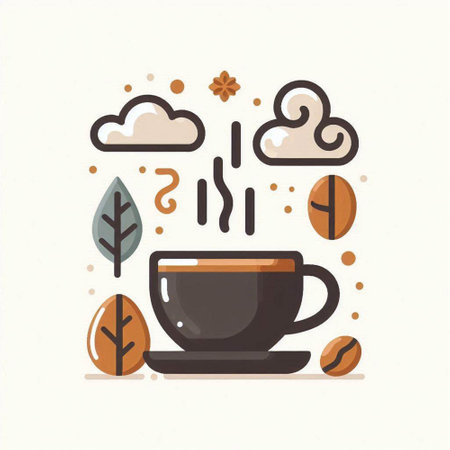1. Introduction: A Nation of Tea and Coffee
The United Kingdom has long been celebrated as a nation steeped in tea tradition, where afternoon tea rituals and classic teapots evoke a sense of timeless British charm. Yet, in recent years, the UK’s café culture has undergone a remarkable transformation, shifting from its historic love affair with tea to an enthusiastic embrace of global coffee trends—most notably, the artful world of lattes. This evolution is not just about taste; it reflects broader cultural shifts, urban lifestyles, and a growing appreciation for craftsmanship in everyday rituals. As latte art becomes a staple feature in independent coffee shops from London to Edinburgh, it signals the UKs openness to global influences while also inspiring local baristas to put their own creative spin on this caffeinated canvas. Exploring the journey from traditional brews to modern masterpieces helps us understand how Britain’s coffee scene now stands at the crossroads of heritage and innovation—a reflection of both its storied past and dynamic present.
2. The Roots of Traditional Latte Art
Long before latte art became an Instagram sensation, its roots were quietly growing in the heart of Europe’s coffee culture. The earliest whispers of this craft can be traced back to Italy in the 1980s, when baristas began experimenting with steamed milk and espresso, swirling them into delicate patterns. By the time British cafés caught wind of these artistic brews, traditional designs such as the rosette and heart had already become hallmarks of continental coffee sophistication.
In Britain, the adoption of latte art signified more than just a nod to European trends—it marked a turning point for local café culture. Where once a cup of coffee might have been briskly poured and handed over, there was now a moment of creative pause: a flourish atop the cup that encouraged customers to linger and appreciate both taste and aesthetics. These classic motifs—simple yet elegant—quickly found favour with British baristas keen to blend artistry with approachability.
European Influences on British Latte Art
Origin |
Signature Design |
Influence on UK Cafés |
|---|---|---|
Italy |
Rosette, Heart | Became standard in artisan cafés across London and beyond |
France |
Tulip, Fern | Brought a sense of Parisian style to British high streets |
Scandinavia |
Swan, Wave | Inspired minimalist designs favoured in Nordic-style UK cafés |
The enduring popularity of these timeless patterns in Britain speaks to a national love for understated elegance. Unlike some global scenes where extravagant pours reign supreme, many UK baristas still pride themselves on perfecting the humble rosette or heart. It’s not just about the visual appeal; these designs are often seen as a mark of skill—a quiet assurance that your coffee has been crafted with care and tradition at its core.

3. Modern Latte Art: Innovation on the British High Street
Step into any bustling British café and you’ll notice that latte art has become much more than a fleeting social media trend—it’s now a canvas for local baristas to showcase genuine creativity. Across the UK, from London’s artisan coffee houses to quirky independents in Manchester or Brighton, modern latte art is all about pushing boundaries. Gone are the days of simple hearts and ferns; today’s lattes bloom with colourful pours using natural dyes, intricate etching, and even 3D foam sculptures.
British baristas have taken inspiration from global trends but infused them with distinctively local flair. Think Union Jack motifs swirling atop oat milk, or seasonal nods like autumn leaves and poppies rendered in caramel and beetroot tints. Specialty cafés often host “latte art throwdowns” where competitors whip up everything from abstract designs to miniature portraits, highlighting not just technical skill but also a sense of playful British wit.
This new wave of creativity mirrors the UK’s wider cultural embrace of individuality and innovation—each cup becomes a statement piece, reflecting both barista personality and customer taste. Whether you’re sipping on a turmeric-infused flat white in Shoreditch or enjoying a matcha latte adorned with geometric patterns in Edinburgh, modern British latte art proves that coffee culture here is as stylish as it is flavourful.
4. Café Culture: The Social Ritual
The British coffee scene has rapidly evolved, with café culture now woven into the social fabric of cities like London, Manchester, Edinburgh, and beyond. Coffee shops are no longer just quick pit-stops for a caffeine fix—they’re vibrant cultural hubs where tradition and innovation blend seamlessly. From classic tearooms serving meticulously crafted flat whites to avant-garde espresso bars flaunting whimsical latte art, these spaces reflect both the nostalgia of British rituals and the pulse of contemporary tastes.
Coffee Shops as Community Hubs
In London’s Soho or Hackney, you’ll spot people gathering for meetings over artisan lattes, while in Manchester’s Northern Quarter, creative minds collaborate at indie cafés dotted with local art. Edinburgh’s Old Town juxtaposes historic charm with trendy coffeehouses attracting students and writers alike. Each region brings its own flavour to the café experience, making it a true reflection of local culture.
Traditionalists vs Modern Aficionados
| Traditionalists | Modern Aficionados | |
|---|---|---|
| Preferred Venue | Cosy tearooms Classic high street cafés |
Boutique espresso bars Pop-up coffee carts |
| Beverage Choice | Straightforward cappuccino Flat white |
Matcha latte Experimental seasonal blends |
| Latte Art Style | Simple rosettas or hearts No-fuss presentation |
Intricate 3D designs Themed or abstract pours |
The Social Ritual Endures
No matter your style—whether you favour a classic milky pour in a vintage china cup or crave an Instagram-worthy masterpiece—the ritual of meeting for coffee remains at the heart of British life. These cafés provide a welcoming space to catch up with mates, tap away on laptops, or simply watch the world go by, all while sipping on a cup that embodies both heritage and modern artistry.
5. British Baristas: Skills, Competitions, and Community
Across the UK, baristas are not just serving coffee—they’re raising the standard of latte art to new heights. From independent cafes in Brighton to specialty shops in Manchester, local talent is reshaping the craft, blending traditional techniques with avant-garde designs. The British barista scene has become renowned for its meticulous attention to detail and a distinct flair that fuses classic Rosetta patterns with modern geometric flourishes.
Spotlight on Local Talent
British baristas like Maxwell Colonna-Dashwood and James Hoffmann have become household names within the coffee community, inspiring a new wave of artists behind the counter. Their influence extends beyond aesthetics; they champion precision brewing and sustainability while mentoring newcomers eager to master both old-school and contemporary latte art.
Competitions: A Platform for Innovation
The annual UK Latte Art Championship is more than just a showcase—it’s a launchpad for creativity. Baristas from across the country compete, demonstrating everything from symmetrical tulips to abstract portraits atop frothy canvases. These events celebrate technical prowess but also foster camaraderie, as participants exchange tips and cheer each other on, embodying the supportive spirit of Britain’s coffee culture.
Training and Community Events
Many cafes now host regular workshops and “latte throwdowns,” where aspiring artists can hone their skills in a friendly, low-pressure environment. Coffee collectives like the London Coffee Network organise meetups and pop-up events, building bridges between traditionalists and innovators. This grassroots approach nurtures a vibrant community where knowledge is shared freely, keeping both heritage and experimentation alive on Britain’s bustling high streets.
6. Sustainability and Ethical Choices
Amidst the swirl of traditional and modern latte art, British coffee shops are facing a new wave of expectations from their discerning clientele: sustainability and ethical responsibility. In cities like London, Manchester, and Bristol, independent cafés are increasingly championing transparent supply chains, seeking out ethically-sourced beans that support fair wages and environmentally-conscious farming methods. As more Britons demand to know the journey of their morning cup, baristas are as likely to chat about single-origin beans and Rainforest Alliance certifications as they are about the intricacies of pouring rosettas or tulips.
Plant-based alternatives have also become a hallmark of this new coffee culture. Oat, almond, and soy milks now feature prominently on menus, with skilled baristas mastering the art of steaming these non-dairy options to create picture-perfect latte art without compromising on taste or texture. This commitment not only caters to vegans and the lactose-intolerant but also reflects a wider shift towards reducing carbon footprints—a cause close to many British hearts.
Eco-friendly practices extend beyond the cup itself. Many coffee shops now offer incentives for reusable cups, have switched to compostable takeaway lids, and prioritise local suppliers to minimise food miles. Whether it’s repurposing spent coffee grounds for garden fertiliser or sourcing pastries from neighbourhood bakers, these choices speak to a uniquely British blend of tradition—valuing community and craftsmanship—and progressive thinking. For today’s UK café-goer, the artistry in their latte is matched by an appreciation for a coffee culture that’s as responsible as it is beautiful.
7. Conclusion: The Evolving British Coffee Identity
The dynamic dance between traditional and modern latte art is crafting a distinctly British coffee culture, one that confidently holds its own on the global stage. Where once a simple flat white or milky brew sufficed, today’s coffee scene in Britain is both a nod to age-old rituals and an embrace of innovation. From the hand-poured rosettas in classic independent cafés to avant-garde creations featuring edible gold or playful stencils, the artistry in every cup tells a story of heritage meeting modern expression. This evolving interplay reflects Britain’s broader cultural narrative—a respect for tradition paired with an appetite for reinvention. As British baristas continue to experiment and consumers develop ever-more discerning palates, the nation’s unique take on latte art not only celebrates diversity but also strengthens its identity within the global coffee landscape. Whether you’re seeking the comforting charm of a time-honoured pour or the visual delight of contemporary designs, Britain’s coffee culture ensures there’s always something to savour—both in taste and in style.

